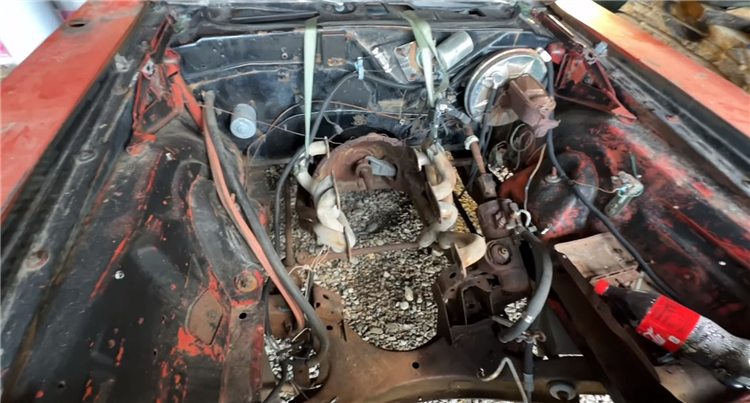Most cars maintained in barns come out of storage in poor condition and with basic features. However, some are discovered as rare diamonds with desirable characteristics. Although the 1971 Dodge Challenger you see here features an uncommon characteristic you wouldn’t anticipate seeing on a Mopar from this model year, it is by no means a rare car. Since the middle of the 1980s, Challenger has been stored in a warehouse. Not unexpected for a classic that has been ignored for almost forty years, it’s in very horrible state. Although it isn’t quite as rusty as anticipated, it nonetheless sustained significant damage, and rodent infestation damaged the interior. The floor pans are also nearly gone, and the dashboard has cracks from prolonged exposure to sunlight.
The original V8 engine is also gone, with only the four-speed manual gearbox still in place. The engine bay includes traces of a big-block V8, but there’s no information on whether the Challenger got such a mill from the factory. Our host also points out that despite all the R/T-style features, this Dodge is not an authentic R/T.
This means it’s one of 18,956 non-R/T Challenger hardtops built in 1971, regardless of powerplant. And it also means it’s a rather mundane example that’s not worth restoring, especially in this condition. However, our host discovered a surprise while closely examining.

The Challenger’s original front end was changed for a 1970 version after it was involved in a serious accident back in the day. The latter, however, wasn’t from a typical automobile. The limited-edition T/A from which the front clip was taken. If this model is foreign to you, it was developed as a homologation-only special for the SCCA Trans-Am series. It was lighter than the typical Challenger and featured some distinctive elements, such as a matte black hood with a big scoop. The latter’s “Six Pack” carburetor setup supplied air to a 340-cubic-inch (5.2-liter) V8 engine rated at 290 horsepower.
Dodge produced the Challenger T/A for only a few months during the 1970 model year, rolling out only 2,399 examples. A one-year gem, the T/A is now a sought-after collectible that changes hands for six-figure sums when still equipped with a numbers-matching powerplant. So how do we know the front clip is indeed from a T/A? Well, it hides a few unique features, starting with a “52” tag on the K frame. It also has three holes in the fender tag area due to its dual-tag layout. Our host also discovered traces of T/A decals on the front fenders.

Does the presence of a T/A front clip raise the value of a plain 1971 Challenger? Even though it doesn’t, finding it on a muscle car that has been hidden for close to 40 years is still a cool feature. And I have no doubt that the owner would easily be able to sell it for a large sum of money. The T/A front end, however, won’t change. For the Muscle Cars at the Strip event in 2024, our host intends to rebuild this vehicle.
And interestingly enough, he decided to go with a 340-cubic-inch “Six Pack” before he found out about the T/A clip. Sure, it’s based on a 1968 block, so it’s not an original T/A powerplant, but it’s the next best thing and a proper pairing. All told, it’s the kind of project you may want to follow if you’re into rat rods.
